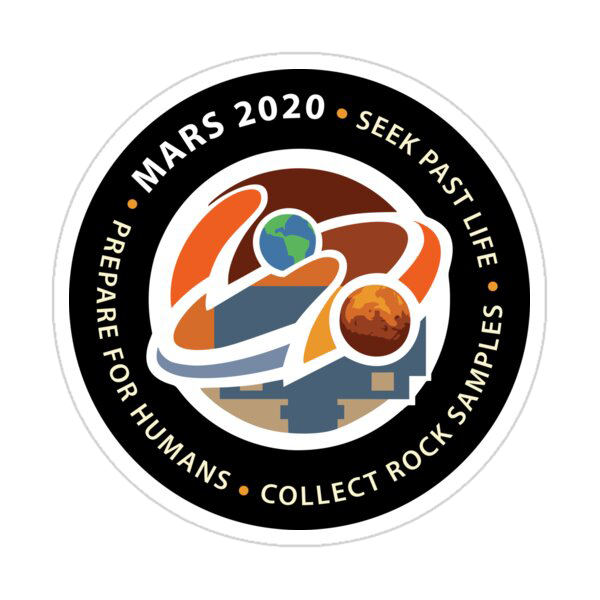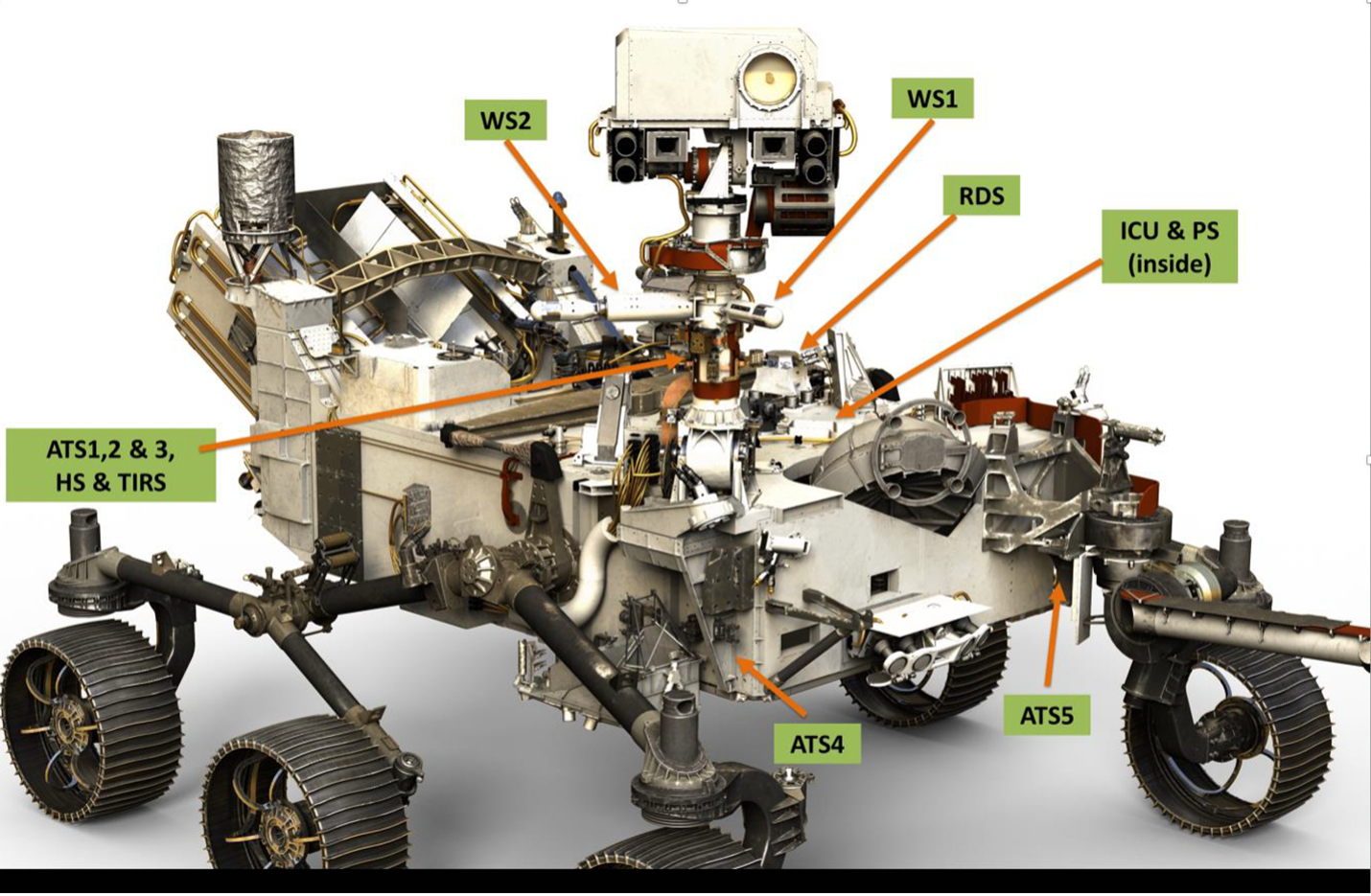
July X, 2021 (Ls X MY X) to [ongoing]
The principal goal of this sensor suite is to provide continuous measurements that characterize the diurnal to seasonal cycles of the local environmental dust properties (opacity, size distribution, and phase function) and their temporal response to meteorology, and the local near-surface environment (pressure, air and surface temperature, relative humidity, wind, and solar radiative forcing in the UV-visible-IR parts of the spectrum).
The MEDA instrument consists of a suite of sensors and a control unit, packaged in eleven enclosures:
The principal goal of this sensor suite is to provide continuous measurements that characterize the diurnal to seasonal cycles of the local environmental dust properties (opacity, size distribution, and phase function) and their temporal response to meteorology, and the local near-surface environment (pressure, air and surface temperature, relative humidity, wind, and solar radiative forcing in the UV-visible-IR parts of the spectrum).
The wind sensors are housed in two small Booms structures mounted orthogonal to the Remote Sensing Mast (RSM) of the Rover. Each Boom provides 6 wind sensor transducer boards on the head of the main boom cylinder. Booms include front-end mixed ASICs to condition and acquire the data from the wind sensors and to communicate serially with the Instrument Control Unit (ICU).
The Thermal-Infrared Radiation Sensor (TIRS) is also mounted on the RSM and it is composed of 5 thermopiles pointing upward and downward to measure different ground and atmosphere temperatures in different infrared bands and the solar radiation reflected on the ground (albedo).
The Radiation and Dust sensor (RDS) is mounted on the rover top deck and comprises of eight upward viewing UV photodetectors (8 photodiodes), 8 lateral viewing UV photodiodes (every photodiode looking 45º apart from the previous to cover the full 360º around the unit), a reference dark-current photodiode and an upward looking camera. The signals coming from these photodiodes and thermopiles will be routed to the ICU to be conditioned and digitized inside the ICU. The ICU will also control the camera through its power and data interfaces.
The instrument control unit, the ICU, is mounted upside-down to the Rover Avionics Mounting Panel (RAMP), inside the rover chassis just under the top deck. It plans and controls the sensors’ data acquisition, communicating with Rover Computer Element (RCE) and temporarily storing science and housekeeping data.
The pressure sensor (PS) is located with the ICU analog module but additionally uses a small tube to reach the Martian environment outside the rover. This tube passes through the ICU base plate, the RAMP, and into a cavity in the rover top deck. The opening is protected from dust and for planetary protection reasons by a cover that attaches to the rover top deck
The instrument will regularly make measurements throughout the Martian day and night, over the lifetime of the Mars 2020 mission. To achieve these measurements, MEDA is designed primarily to operate from an autonomous, low-power “sleep” mode, which can be powered even while the RCE is off. An internal timer wakes MEDA to take observations according to a pre-determined schedule, saves the data internally, and goes back to sleep. Instrument housekeeping tasks can also be performed to a schedule.
Farley, K.A., Williford, K.H., Stack, K.M. et al. Mars 2020 Mission Overview. Space Sci Rev 216, 142 (2020). https://doi.org/10.1007/s11214-020-00762-y
Balaram, J., Aung, M. & Golombek, M.P. The Ingenuity Helicopter on the Perseverance Rover. Space Sci Rev 217, 56 (2021). https://doi.org/10.1007/s11214-021-00815-w
SISLink to SIS File
Each MEDA Science Data Product RDR will consist of two files. The first file is an XML formatted detached PDS4 label. The second file is the corresponding data as described in the label file, in ASCII format, comma separated values. The MEDA RDR data file contains science and engineering calibrated data, as processed from the raw data included in MEDA EDRs, which are in turn contain the data as downloaded from MEDA’s internal memory. Mirroring MEDA EDRs, each sensor subsystem will be stored in a separate MEDA RDR. For a description of MEDA EDR format, refer to the Mars2020 Applicable Document 4 (MEDA EDR SIS).
Each MEDA RDR contains one SOL of data. The size of each MEDA RDR data file will depend on the type of data, the measurement strategies and if all data were received, or if only partial data are available. If there are updates to the source raw data or to the calibration processes, the file will be updated and its version number will be incremented. The version number will be indicated in the filename. The latest version of the file should always be used, with previous versions kept only for historical purposes.
Each row within each data product is accompanied by three clock references fields: SCLK (as approximated by MEDA internal clock, without partition and including decimal thousandths of a second), LMST and LTST
Raw Data
Partially Processed Data
Pressure
Relative Humidity
TIRS
ATS
Wind
RDS
Calibrated Data
Pressure
Relative Humidity
TIRS
ATS
Wind
RDS
Engineering
Derived Data
The Instrument Package
The MEDA instrument consists of a suite of sensors and a control unit, packaged in eleven enclosures:
- Wind Sensor, WS (two detectors, WS1 and WS2, placed on two booms)
- Air Temperature Sensor, ATS (five detectors: three of them placed on the RSM, and two more at the front of the rover body)
- Thermal Infra-Red Sensor, TIRS
- Relative Humidity Sensor, HS
- Radiation and Dust Sensor, RDS (it also includes the SkyCam imager, not covered in this SIS)
- Pressure Sensor, PS (inside the Instrument Control Unit, ICU)
The principal goal of this sensor suite is to provide continuous measurements that characterize the diurnal to seasonal cycles of the local environmental dust properties (opacity, size distribution, and phase function) and their temporal response to meteorology, and the local near-surface environment (pressure, air and surface temperature, relative humidity, wind, and solar radiative forcing in the UV-visible-IR parts of the spectrum).
The wind sensors are housed in two small Booms structures mounted orthogonal to the Remote Sensing Mast (RSM) of the Rover. Each Boom provides 6 wind sensor transducer boards on the head of the main boom cylinder. Booms include front-end mixed ASICs to condition and acquire the data from the wind sensors and to communicate serially with the Instrument Control Unit (ICU).
The Thermal-Infrared Radiation Sensor (TIRS) is also mounted on the RSM and it is composed of 5 thermopiles pointing upward and downward to measure different ground and atmosphere temperatures in different infrared bands and the solar radiation reflected on the ground (albedo).
The Radiation and Dust sensor (RDS) is mounted on the rover top deck and comprises of eight upward viewing UV photodetectors (8 photodiodes), 8 lateral viewing UV photodiodes (every photodiode looking 45º apart from the previous to cover the full 360º around the unit), a reference dark-current photodiode and an upward looking camera. The signals coming from these photodiodes and thermopiles will be routed to the ICU to be conditioned and digitized inside the ICU. The ICU will also control the camera through its power and data interfaces.
The instrument control unit, the ICU, is mounted upside-down to the Rover Avionics Mounting Panel (RAMP), inside the rover chassis just under the top deck. It plans and controls the sensors’ data acquisition, communicating with Rover Computer Element (RCE) and temporarily storing science and housekeeping data.
The pressure sensor (PS) is located with the ICU analog module but additionally uses a small tube to reach the Martian environment outside the rover. This tube passes through the ICU base plate, the RAMP, and into a cavity in the rover top deck. The opening is protected from dust and for planetary protection reasons by a cover that attaches to the rover top deck
The instrument will regularly make measurements throughout the Martian day and night, over the lifetime of the Mars 2020 mission. To achieve these measurements, MEDA is designed primarily to operate from an autonomous, low-power “sleep” mode, which can be powered even while the RCE is off. An internal timer wakes MEDA to take observations according to a pre-determined schedule, saves the data internally, and goes back to sleep. Instrument housekeeping tasks can also be performed to a schedule.
Useful Publications
Farley, K.A., Williford, K.H., Stack, K.M. et al. Mars 2020 Mission Overview. Space Sci Rev 216, 142 (2020). https://doi.org/10.1007/s11214-020-00762-y
Balaram, J., Aung, M. & Golombek, M.P. The Ingenuity Helicopter on the Perseverance Rover. Space Sci Rev 217, 56 (2021). https://doi.org/10.1007/s11214-021-00815-w
Documents
The Mars Environmental Dynamics Analyzer, MEDA. A Suite of Environmental Sensors for the Mars 2020 Mission.
SIS
Archive Products
Each MEDA Science Data Product RDR will consist of two files. The first file is an XML formatted detached PDS4 label. The second file is the corresponding data as described in the label file, in ASCII format, comma separated values. The MEDA RDR data file contains science and engineering calibrated data, as processed from the raw data included in MEDA EDRs, which are in turn contain the data as downloaded from MEDA’s internal memory. Mirroring MEDA EDRs, each sensor subsystem will be stored in a separate MEDA RDR. For a description of MEDA EDR format, refer to the Mars2020 Applicable Document 4 (MEDA EDR SIS).
Each MEDA RDR contains one SOL of data. The size of each MEDA RDR data file will depend on the type of data, the measurement strategies and if all data were received, or if only partial data are available. If there are updates to the source raw data or to the calibration processes, the file will be updated and its version number will be incremented. The version number will be indicated in the filename. The latest version of the file should always be used, with previous versions kept only for historical purposes.
Each row within each data product is accompanied by three clock references fields: SCLK (as approximated by MEDA internal clock, without partition and including decimal thousandths of a second), LMST and LTST
Raw Data
Partially Processed Data
Pressure
Relative Humidity
TIRS
ATS
Wind
RDS
Pressure
Relative Humidity
TIRS
ATS
Wind
RDS
Engineering
Pressure
Relative Humidity
TIRS
Wind
Ancillary
Relative Humidity
TIRS
Wind
Ancillary
 PDS: The Planetary Atmospheres Node
PDS: The Planetary Atmospheres Node


